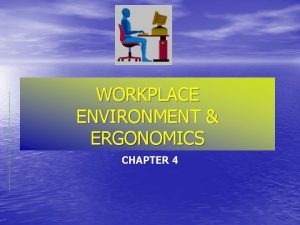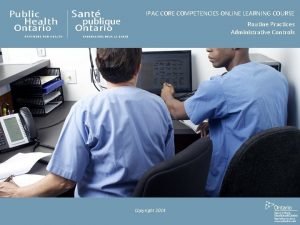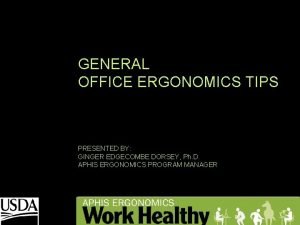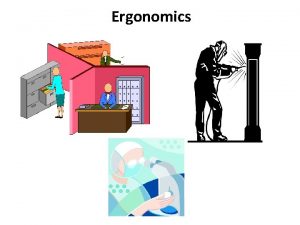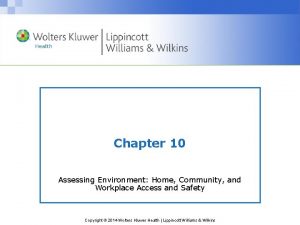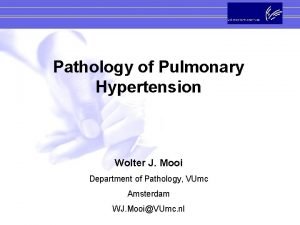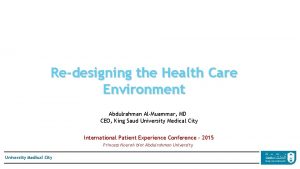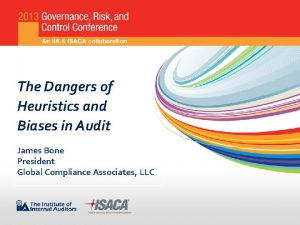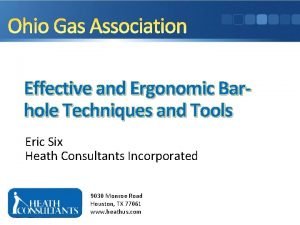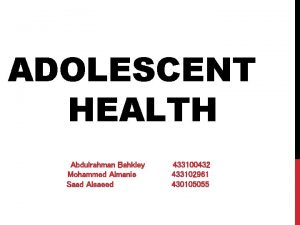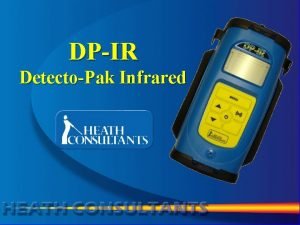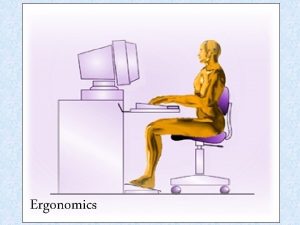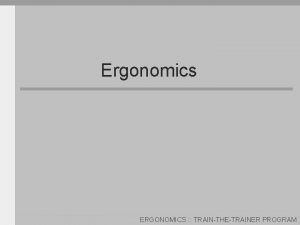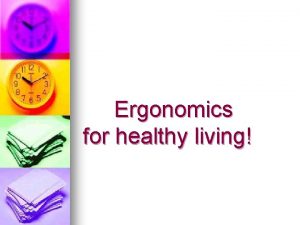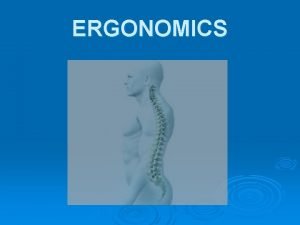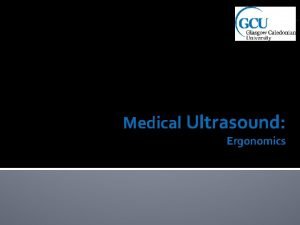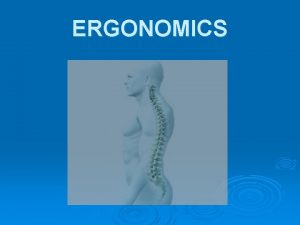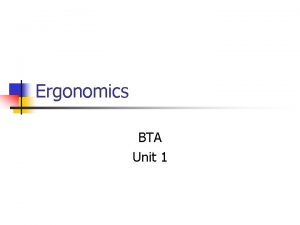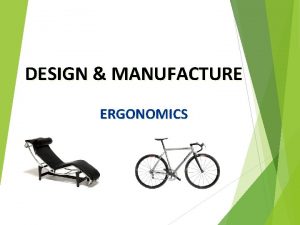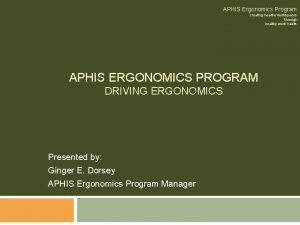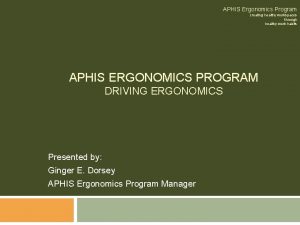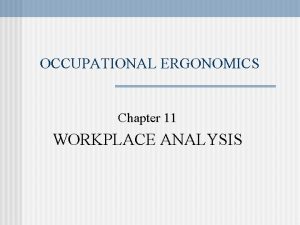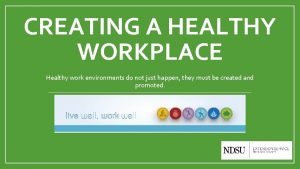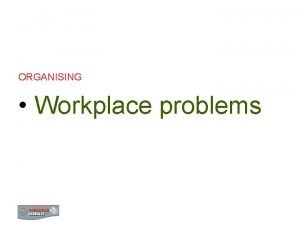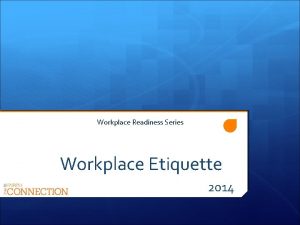Office Ergonomics Creating a Healthy Workplace Environmental Heath




































- Slides: 36

Office Ergonomics Creating a Healthy Workplace Environmental Heath & Safety Department G-4 TPP 65. 2. 13

What is Ergonomics? Ø ERGO = “work” Ø NOMICS = “rules” or “laws” Ø Ergonomics literally means “the laws of work” Environmental Heath & Safety Department

What is Ergonomics? Ø OSHA defines ergonomics as the science of “designing the job to fit the worker, instead of forcing the worker to fit the job. ” Environmental Heath & Safety Department

What is Ergonomics? Ø Ideally, good ergonomic conditions: - Make the job safer by preventing injury and illness - Make the job easier by adjusting the job to the worker - Make the job more pleasant by reducing physical and mental stress - Save money $$$ Environmental Heath & Safety Department

Ergonomic Factors Ø Two Categories of Ergonomic Factors to be considered - Environmental conditions – your physical surroundings - Physical stressors – how your body reacts to work practices Environmental Heath & Safety Department

Environmental Factors Ø Environmental factors may affect: - Hearing Vision - - Dim lighting or glares from windows General comfort and health - Hard seats or cramped spaces Environmental Heath & Safety Department

Environmental Factors Ø Causes of these problems are: - Excessive noise Improper lighting Temperature extremes Sick Building Syndrome Environmental Heath & Safety Department

Physical Stressors Ø Physical stressors place pressure or stress on parts of the body: - Ø Joints, muscles, nerves, tendons, bones Injuries cause by physical stressors are referred to as “Cumulative Trauma Disorders” (CTDs) or “Repetitive Strain Injuries” (RSIs) Environmental Heath & Safety Department

Cumulative Trauma Disorders (CFDs) Ø Cumulative = occurring gradually over a period of weeks, months, or years Ø Trauma = bodily injury to nerves, tissues, tendons, or joints Ø Disorders =conditions causing physical ailments or abnormal conditions Environmental Heath & Safety Department

Cumulative Trauma Disorders Ø Examples of Cumulative Trauma Disorders include: - Carpal Tunnel Syndrome Epicondylitis (tennis elbow) Tenosynovitis (trigger finger) Bursitis Environmental Heath & Safety Department

Risk Factors Ø The main risk factors for officerelated CTDs are: - Repetition - Awkward positions or posture - Excessive pressure or force Ø Another risk factor for CTDs would be: - Vibration Environmental Heath & Safety Department

Risk Factors: Repetition Ø The majority of CTDs are caused by repetitive motions that would not result in injury if only performed once. - Thousands of keystrokes typing - Hours of filing, day after day - Stamping dozens of papers - Frequent lifting - Repeated motions with computer mouse Environmental Heath & Safety Department

Risk Factors: Awkward Positions - Leaning forward at your desk - Typing with wrists at an odd angle - Raising shoulders while typing Environmental Heath & Safety Department

Risk Factors: Awkward Positions - Reaching to use mouse - Twisting neck to look at monitor or phone Environmental Heath & Safety Department

Risk Factors: Excessive Force Ø Typing with too much force or “pounding’ the keys Ø Stamping Ø Lifting heavy boxes of paper or carrying office equipment Ø Using improper grip Environmental Heath & Safety Department

But the good news is …. There are simple ways to help yourself! Environmental Heath & Safety Department

Prevention Strategies Ø Avoid leaning forward at your desk - Maintain natural “s” curve of your spine Support lower back Keep feet supported on floor or use a foot rest Environmental Heath & Safety Department

Prevention Strategies Ø The elbows should be at a comfortable angle while "hanging" at the sides from the shoulders. Ø The shoulders should remain relaxed in a lowered position while typing. Environmental Heath & Safety Department

Prevention Strategies Ø Avoid typing with wrists at an odd angles - keep them in the neutral position, not bent up or down, or side-to-side Environmental Heath & Safety Department

Neutral Wrist Position Keyboard positioned at elbow height and flat - Avoid contact stress while typing - Use proper posture and keying technique Your arms should float over the keyboard as if playing the piano Environmental Heath & Safety Department

Prevention Strategies Ø The keyboard should be slightly lower than normal desk height. - If it is not low enough, try raising your chair height. Prevent your legs from dangling by using a footrest. Ø Keep "home row" of keys at elbow level. Ø Adjust your chair! Environmental Heath & Safety Department

Neutral Posture for Computer Use Position the monitor directly in front of you and about an arm’s length away. The top row of characters on the screen should be no higher than seated eye height Use a document holder close to the monitor Mouse should be next to the keyboard, both at a height equivalent to your seated elbow height Knees comfortably bent with feet resting on the floor. If the chair is raised so the keyboard height equals elbow height, use a foot rest to encourage sitting fully back on the chair Adjust the seat height so upper arms hang vertically, close to the body, elbows bent about 90 degrees, shoulders relaxed and wrists straight Adjust the back rest to provide firm support to the small of the back The seat pan supports the thighs but does not contact the back of the knees Environmental Heath & Safety Department

Prevention Strategies Ø Do not pound the keys. Use a light touch. Ø Use two hands to perform double key operations like Ctrl-C or Alt-F instead of twisting one hand to do it. Ø Position frequently used equipment so that you don’t have to reach for it. Environmental Heath & Safety Department

Prevention Strategies Ø Place monitor in front of you, not off at an angle. Ø Take lots of breaks to stretch and relax. Ø Hold mouse lightly. Ø Keep your hands and arms warm. Environmental Heath & Safety Department

Prevention Strategies Ø Pay attention to the signals your body provides you. - If your neck hurts at work, examine your body position to try to figure out what might be causing the soreness. - Are you holding your neck at an awkward angle while you type or talk on the phone? Environmental Heath & Safety Department

Vision Related Work Habits Ø 20/20 Rule Ø Blink/refocus eyes regularly Ø Keep monitor screen clean Regular vision care Environmental Heath & Safety Department

Prevention Strategies Ø If you are experiencing symptoms of CTDs… - Tingling or numbness in the hands or fingers Pain in fingers, hands wrists, or even shooting up into the arms or forearms Loss of strength or coordination in the hands Numbness or discomfort in the hands that wakes you up at night. . SEE A DOCTOR! Environmental Heath & Safety Department

But What About Headaches? Ø Many office-related headaches are caused by eyestrain. - Dry eyes - Monitor glare - Tired/strained eye muscles Environmental Heath & Safety Department

Eyestrain Ø Position monitor at a comfortable distance Ø Avoid glare Ø Adjust VDT brightness and contrast Ø Keep screen clear of dust Ø Look up and away every few minutes or so! Environmental Heath & Safety Department

Ergonomic Products Ø There a variety of ergonomic products available on the market, including: - Keyboards - Wrist rests - Mouse pads - Chairs - Adjustable desks - Glare screens Environmental Heath & Safety Department

Other Equipment Ø Head sets - Recommended when on the phone for extended periods of time, receive frequent calls. - Important for people who write or use the computer while talking on the phone. Environmental Heath & Safety Department

Other Equipment Ø Sit to stand workstations - - Allows for macro changes in posture Minimizes fatigue or discomfort associated with continuous sitting or standing Can be beneficial for those with back pain Environmental Heath & Safety Department

Proper Lifting Ø Lifting improperly can result in - Muscle strains - Ligament sprains - Vertebral disk herniations - Abdominal hernias Environmental Heath & Safety Department

Proper Lifting Ø Plan ahead - Clear pathway to ensure safe path - Is the load to heavy to carry by yourself? Get help. Environmental Heath & Safety Department

Proper Lifting Ø Keep your feet shoulder-width apart Ø Squat down – bend at knees and hips Ø Keep back straight, chest out, shoulders back Ø Hold load close to body, close to center of mass Ø Use feet to change direction; DO NOT TWIST BODY Environmental Heath & Safety Department

Additional Resources … ØOSHA - http: //www. osha. gov/SLTC/ergonomics/resources. html ØCDC/NIOSH – http: //www. cdc. gov/niosh/topics/ergonomics/ ØMayo Clinic – http: //www. mayoclinic. com/health/officeergonomics/MY 01460 Environmental Heath & Safety Department
 Workplace environment and ergonomics
Workplace environment and ergonomics Ipac course online
Ipac course online Healthy workplace
Healthy workplace Office ergonomics
Office ergonomics Ferro foundries pvt ltd
Ferro foundries pvt ltd Workplace environmental assessment
Workplace environmental assessment Healthy nurse healthy nation
Healthy nurse healthy nation Journal on healthy food healthy mind
Journal on healthy food healthy mind Healthy soil healthy life poster ideas
Healthy soil healthy life poster ideas Healthy forests healthy communities poster ideas
Healthy forests healthy communities poster ideas Mh 605
Mh 605 Office of healthy schools
Office of healthy schools Crossley heath term dates
Crossley heath term dates Heath edwards classification
Heath edwards classification Heath abdulrahman
Heath abdulrahman Heath of the brandenburg march
Heath of the brandenburg march Julie majewski
Julie majewski Switch heath
Switch heath Switch heath
Switch heath Ron fink and john heath
Ron fink and john heath Barhole
Barhole Heath bar shake
Heath bar shake Heath abdulrahman
Heath abdulrahman Death of heath ledger
Death of heath ledger Coleshill heath school
Coleshill heath school Heath dpir
Heath dpir Heath end school
Heath end school Little heath sixth form
Little heath sixth form Noah heath
Noah heath Heath ledger bio
Heath ledger bio Heath abdulrahman
Heath abdulrahman Helene heath
Helene heath Nick leeson barings bank
Nick leeson barings bank Capello clo
Capello clo Clubhouse introduction
Clubhouse introduction Flynn heath holt
Flynn heath holt Heath carroll
Heath carroll
